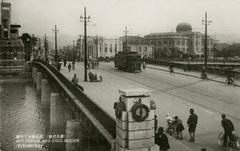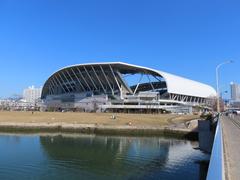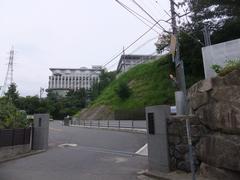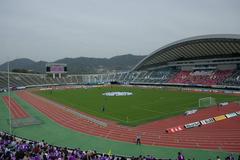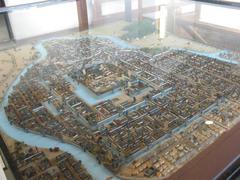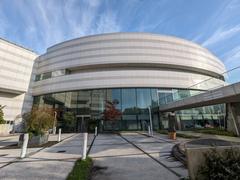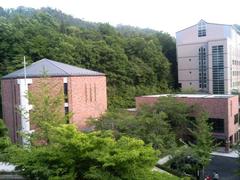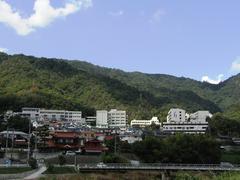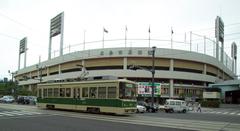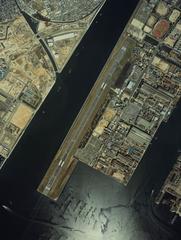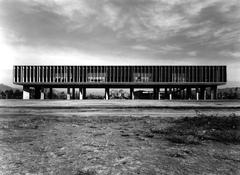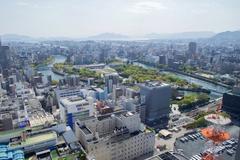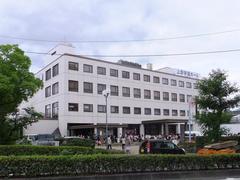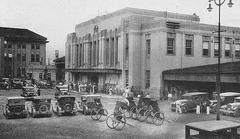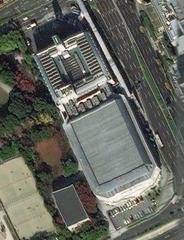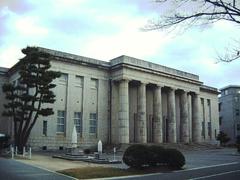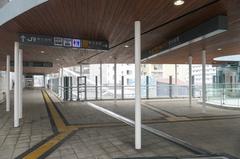Hiroshima Local Meteorological Observatory: Visiting Hours, Tickets, and Historical Significance
Date: 04/07/2025
Introduction
Situated in the heart of Hiroshima, the Hiroshima Local Meteorological Observatory (広島地方気象台, Hiroshima Chihō Kishōdai) stands as a beacon of scientific advancement and resilience. Established in the early 20th century, it has played a critical role in weather forecasting, disaster prevention, and climate monitoring for the region—a region known for both its natural beauty and vulnerability to severe weather and seismic events. This guide offers a comprehensive overview of the Observatory’s historical significance, visitor information, and practical tips for making the most of your visit, including essential details about the related Hiroshima City Ebayama Museum of Meteorology.
For current visiting hours, ticket details, and the latest event schedules, consult the official Japan Meteorological Agency (JMA) and local tourism resources such as Tourist in Japan and Travellers Worldwide.
Table of Contents
- Introduction
- Historical Development and Role in Regional Meteorology
- The Observatory During and After World War II
- Postwar Reconstruction and Modernization
- Scientific Contributions and Disaster Prevention
- Research, Climate Monitoring, and Cultural Impact
- Visiting Information: Hours, Tickets, and Accessibility
- Hiroshima City Ebayama Museum of Meteorology: Guide and Highlights
- Nearby Historical Sites and Travel Tips
- Frequently Asked Questions (FAQ)
- Conclusion
- References
Historical Development and Role in Regional Meteorology
Meteorological observation in Hiroshima began in the late 19th and early 20th centuries, coinciding with Japan’s era of modernization. The Observatory was established as part of the Japan Meteorological Agency (JMA) network to provide accurate weather data for Hiroshima Prefecture—a region frequently impacted by typhoons, torrential rain, and earthquakes.
Throughout its history, the Observatory has been instrumental in supporting agriculture, transportation, and public safety. Its meticulous data collection has enabled the development of reliable forecasting and disaster mitigation strategies, especially in a region where weather-related hazards are common.
The Observatory During and After World War II
During World War II, the Observatory provided essential weather intelligence for military and civilian purposes. The atomic bombing of Hiroshima on August 6, 1945, devastated much of the city; however, the Observatory building survived, albeit with visible damage. Meteorological records from that day have become invaluable for understanding the environmental consequences of the bomb, including the phenomenon of radioactive “black rain.”
After the war, the Observatory’s reconstruction became a symbol of Hiroshima’s resilience and dedication to disaster preparedness and scientific progress.
Postwar Reconstruction and Modernization
In the decades following the war, the Observatory was modernized with advanced technologies such as radar systems and automated weather stations. It has continued to evolve, serving as a hub for issuing typhoon warnings, earthquake alerts, and supporting urban planning and education on disaster prevention.
Scientific Contributions and Disaster Prevention
The Observatory’s core functions include:
- Weather Forecasting: Providing daily and weekly forecasts that support agriculture, tourism, and public safety.
- Disaster Warnings: Issuing real-time alerts for typhoons, heavy rain, floods, landslides, and earthquakes.
- Climate Monitoring: Collecting long-term data critical for tracking climate change and supporting scientific research.
- Environmental Observation: Monitoring air quality and pollen levels to inform public health initiatives.
The Observatory’s data and expertise have been crucial during events such as the July 2018 torrential rain and landslides, when timely warnings helped save lives and guide emergency responses (Geoenvironmental Disasters, Hiroshima Prefecture Disaster Reports).
Research, Climate Monitoring, and Cultural Impact
The Hiroshima Local Meteorological Observatory is a center for ongoing research on regional climate change, collaborating with academic and international partners. Its data have been foundational for studies on climate trends and extreme weather in western Japan (Mori et al., 2021).
A unique cultural contribution is its participation in the annual cherry blossom forecast, a significant nationwide event. The Observatory is one of Japan Weather Association’s (JWA) 53 sample sites for observing cherry blossom phenology, with its data helping predict the opening and full bloom dates, eagerly anticipated across Japan (Japan Weather Association, 2025).
Visiting Information: Hours, Tickets, and Accessibility
Hiroshima Local Meteorological Observatory
- Visiting Hours: The Observatory is primarily a working facility, but it opens to the public during special events and by prior arrangement. Typical public hours are 9:00 AM to 4:00 PM on selected weekends and holidays. Always verify current schedules on the JMA website.
- Admission: Free for general visits; some special tours or workshops may require advance booking and a small fee.
- Guided Tours: Offered on open days, with staff explaining the history, current technology, and disaster preparedness efforts.
- Accessibility: The facility is wheelchair accessible; contact ahead for assistance with specific needs.
- Location: Central Hiroshima, accessible by public transportation (bus and tram); parking available nearby.
Hiroshima City Ebayama Museum of Meteorology
Overview
Located atop Mt. Eba in Hiroshima City, the Hiroshima City Ebayama Museum of Meteorology occupies the historic Observatory building, one of few structures to survive the 1945 atomic bombing. The museum combines interactive meteorological exhibits with preserved evidence of atomic bomb damage, offering a powerful blend of science and history.
Details
- Address: 34-1 Eba-minami, Naka-ku, Hiroshima, 730-0835, Japan (Google Maps)
- Website: Hiroshima City Ebayama Museum of Meteorology (Japanese)
- Visiting Hours: Monday to Friday, 9:00 AM to 5:00 PM (closed on national holidays and for maintenance; check the official site for updates).
- Admission: 200–400 JPY for adults; discounts for students, seniors, and children. Group rates and advance booking for tours are available.
- Facilities: Permanent and special exhibitions, preserved bomb damage, museum shop, restrooms, and partial wheelchair access.
- Getting There: Tram (Line 6) to Eba Station, then a 10-minute walk; city buses also serve the area. Parking is limited; public transport is recommended.
- Special Events: World Meteorological Day, workshops, and rotating exhibits focused on weather, disaster response, and the science of forecasting.
Nearby Historical Sites and Travel Tips
While visiting, consider exploring:
- Hiroshima Peace Memorial Park and the Atomic Bomb Dome: Iconic sites memorializing the victims of the atomic bombing.
- Hiroshima Castle: Reconstructed historical landmark with beautiful gardens.
- Shukkeien Garden: Traditional Japanese garden, ideal for quiet reflection.
- Ebayama Park: Surrounds the museum and offers panoramic views.
Travel Tips:
- Use public transportation to avoid parking challenges.
- Spring and autumn offer the most pleasant weather for sightseeing.
- Combine your visit to the Observatory or Museum with other nearby attractions for a full day of learning and exploration.
Frequently Asked Questions (FAQ)
Q: What are the Hiroshima Local Meteorological Observatory’s visiting hours?
A: Public access is generally available during special open days, typically from 9:00 AM to 4:00 PM on select weekends and holidays. Confirm current schedules on the JMA website.
Q: Is there an admission fee?
A: The Observatory is free to visit; the Hiroshima City Ebayama Museum of Meteorology charges a modest admission fee (200–400 JPY).
Q: Are guided tours available?
A: Yes, both the Observatory (on open days) and the Museum offer guided tours—advance booking is recommended for groups.
Q: Is the facility accessible for visitors with disabilities?
A: Both sites are generally accessible, with wheelchair ramps and elevators. Some historic areas of the Museum may have uneven ground.
Q: Can I take photographs?
A: Photography is allowed in most areas but may be restricted near sensitive equipment or in memorial spaces. Ask staff for guidance.
Q: What’s the best way to get there?
A: Both sites are centrally located and easily reached by tram, bus, or taxi from Hiroshima Station.
Conclusion
The Hiroshima Local Meteorological Observatory, and its historic counterpart the Hiroshima City Ebayama Museum of Meteorology, represent the union of scientific innovation, disaster resilience, and cultural memory. From pioneering meteorological observation to supporting Hiroshima’s recovery after World War II, the Observatory continues to serve the community through research, education, and real-time disaster response.
A visit here offers more than insight into weather science; it’s an opportunity to reflect on the city’s enduring spirit and the essential role of preparedness in shaping a safer future. Plan your visit by checking official updates, and enrich your Hiroshima experience by exploring nearby landmarks and engaging with the city’s vibrant history and culture.
For additional planning resources, consult the Japan Meteorological Agency, Hiroshima City Ebayama Museum of Meteorology, and the Hiroshima tourism portal.
References
- Japan Meteorological Agency (JMA)
- Geoenvironmental Disasters
- Hiroshima Prefecture Disaster Reports
- Hiroshima City Ebayama Museum of Meteorology (Japanese)
- Japan Weather Association: Cherry Blossom Forecast 2025
- Tourist in Japan
- Travellers Worldwide
For more details on disaster response, climate research, and visiting tips, explore these links and official resources.
